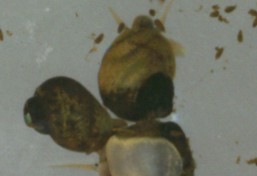
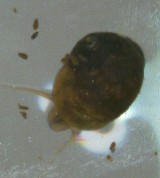
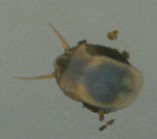
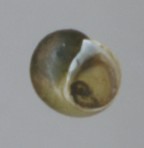
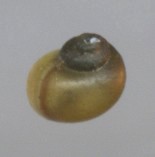
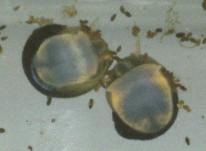
Hydrobiidae (Somatogyrus), unknown species, from the Chunkey River, Mississippi, United States. Collected September 2000.
Freshwater Molluscan Shells






Hydrobiidae (Somatogyrus),
unknown species, from the Chunkey River, Mississippi, United
States. Collected September 2000.
Hydrobiidae and Allied Families (Superfamily Rissoacea, Hydrobioidea, or Truncatelloidea)
World wide, these are the small ones, ranging down almost to the microscopic. Magnifications used here are approximately 4 x and 8 x, for filenames ending with 300 and 600 respectively (see scales). In the author's experience in the south-central United States, such "microshells" are generally uncommon, only occasionally found in flood-deposited creek drift. In some instances they can be abundant, as in widely scattered springs, or at one locality in coastal Georgia where a few seeps flow around cement sidewalks, and another, a reach of the Chunkey River in Mississippi, where they swarmed over bedrock, filamentous algae, and sand. Thompson, in http://www. flmnh. ufl.edu/natsci/malacology/fl- snail/snails1.htm indicates that many species are annual, with a single brood, and a complete turnover of individuals every year. He also points out that there is a great deal more variation between various taxa than would be suggested by the often similar shells.
Classification:
The classification of this enormous group of organisms is under review. Banarescu provides the following information:Pomatiopsidae: Two subfamilies Pomatiopsinae, and Triculinae. Pomatiopsinae contains genera Erhaia, China; Aquidauania, central South America; Tomichia, South African rivers; Coxiella and Coxielladda from west and south Australia; Oncomelania, from east Asia; Blanfordia, and Fukuia, Japan; Cecina, Japan, Manchuria, and western North America; and Pomatiopsis, North America. The Triculinae include twelve genera, all in south and southeast Asia. Nine are endemic to the Mekong River.
Bithyniidae: Gabbiella, central Africa; Jubaia, and Incertihydrobia, east Africa; Sierraia, west Africa; Funduella, Limnitesta, and Congodoma, south-central Africa; Gabbia, central Australia; Emmericiopsis, Mysorella, Parabithynia, Pseudovivipara, and Sataria, endemic in various locations, south, and southeast Asia; Hydrobioides, south Asia; Petroglyphus, Phillipines; Allocinma, widespread in southern Asia; Bithynia, Europe through central Asia, introduced (possibly native) to North America.
Baicaliidae: Baicalia, endemic to Lake Baical.
Benedictiidae: Kobeltocochlea, Lake Baical and Lake Hubsugul (Mongolia); Benedictia, Lake Baical.
Pyrgulidae: Several genera in southern Europe and Turkey, one, Antroselates, in Indiana and Kentucky caves. Burch, 1982 includes this later with family Micromelaniidae.
Hydrobiidae: A very large family with hundreds of genera. These can be grouped into a number of subdivisions, many of which are considered distinct families or subfamilies by various authors. Banarescu discusses some of the disagreements in classification schemes, and offers the following informal groupings, or "lineages":
Lithoglyphine, eastern and far western North America, southern Europe.
Glacidorbis, Tasmania, south Australia, and Chile.*
Orientaliine - horatiine - amnicoline, eastern and north-central North America; many genera, subfamilies in southern and central Europe, Turkey.
Fontigentine, eastern North America.
Nymphophiline; most of area of United States.
Cochliopinine; Central America, Antilles, Peru.
Littoridinine; Mexico, Central and northern South America.
Mexithaumine; Rio Grande, Equador.
Emmericiine; western Balkan Peninsula.
Lithoglyphuline; western Balkan Peninsula, Danube basin.
Bythinelline; Europe, largely on southern peninsulas.
Moitessierine; Europe, largely on southern peninsulas.
Fluvipupa; Australia, New Guinea, Tasmania, New Zealand.* Ponder (1986) assigns the genus Glacidorbis to its own family and superfamily within the pulmonate Basommatophora!
A commonly used classification scheme for the hydrobiidae is based on anatomical structures of the male reproductive organ or "verge" (Burch,1982), although there is question as to whether the resulting system is correct. He includes three families, five subfamilies, 29 genera, four additional subgenera, and 158 species for North America in his superfamily Truncatelloidea. He places the family Bithyniidae, with its one probable introduced species in North America, in the superfamily Ampullarioidea, (Viviparoidea) however, with the much larger Viviparidae and Ampullariidae.
Truncatelloidea
Micromellaniidae: Antroselates spiralis alone in North America is included in this family. Based on radular characteristics, it includes species from Lake Baikal, and other large lakes in southeastern Europe and Asia.
Hydrobiidae:
Hydrobiinae: Aphastracon, Hoyia, hyalopyrgus, Littoridinops, Probythinella, Pyrgophorus, Tryonia.
Lithoglyphinae: Antrobia, clappia, Cochliopina, Fluminicola, Gillia, Lepyrium, Somatogyrus (Somatogyrus s.s., and Walkerilla).
Nymphophalinae: Birgella, Cincinnattia, Fonticella (Fonticella s.s., Microamnicola, and Natricola), Marstonia, Notogilla, Orygoceras (name under review), Pyrgulopsis, Rhapinema, Spilochlamys, Stiobia..
Amnicolinae: Amnicola (Amnicola s.s., and Lyogyrus), Hauffenia, Horatia.
Fontigentinae: Fontigens.
incertae sedis: three species.Pomatiiopsidae Pomatiopsis.
North America
Pomatiopsis lapidaria (Say, 1817)
south central United States. (Pomatiopsidae)Fluminicola nuttalliana (Lea, 1838)
Columbia River basin, Pacific northwest.
(Hydrobiidae) Up to 10 mm, relatively large
for the family, it inhabits most creeks and
small rivers. Operculum, inner side, upper
left.
Probable Marstonia species, from spring in
upper East Tennessee, February, 2002. Of a
number of specimens examined, none displayed
the verge, suggesting parthenogenicity in the
population.
Europe
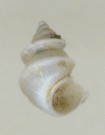
Chilopergula prespensis
(Urbansky) Macedonia.
(Micromelaniidae)Emmercia patula (Brumati, 1838)
Croatia. (Micromelaniidae)Bithynia leachi Italy.
(Bithyniidae)
Lithoglyphus naticoides (Pfeiffer)
Hungary. (Hydrobiidae)Potamopyrgus jenkensi E. A. Smith
Hungary. (Hydrobiidae)
Asia
Bythnia kiusiuensis (Hirase, 1957)
Japan. (Bithyniidae)Gabbia longicornis (Benson)
Viet Nam. (Bithyniidae)Bithynia tentaculata (L., 1758)
Europe, Asia, and North America
(introduced). (Bithyniidae)Stenothyra basiangulata Mori,
1838 Japan. (Stenothyridae) Brandt
(1974) includes 16 freshwater and 15
brackish water species for the territory
of Thailand in Stenothyra.Caspiohydrobia issykkulensis
(Clessin, 1894) Kyrgystan.
(Hydrobiidae)Paludinella devilis
(Gould, 1861) Japan.
(Hydrobiidae)Hydrobioides striatulus
(Benson) Viet Nam. (Hydrobiidae)Blanfordia japonica
(A. Adams, 1854)
Japan. (Pomatiopsidae)Fluvicingula elegantula
(A. Adams, 1861), Japan.
(Iravadiidae)
Mekong River Pomatiopsidae:

|
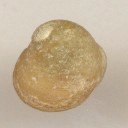
|

|

|
|||||||
| Paraprosthenia levayi (Bavay, 1895) x8 |
Lacunopsis harmandi Poirier, 1881. x4 |
Pachyhydrobia spinosa Poirier, 1881 x4 Note single spine on back of shell. |
Jullienia harmandi Poirier, 1881. x4 |
South America
Litoridina australis
(d'Orbigny, 1835),
Uruguay. (Hydrobiidae)Potamolithus jacuyensis Pilsbry,
1899 Brazil. (Hydrobiidae)